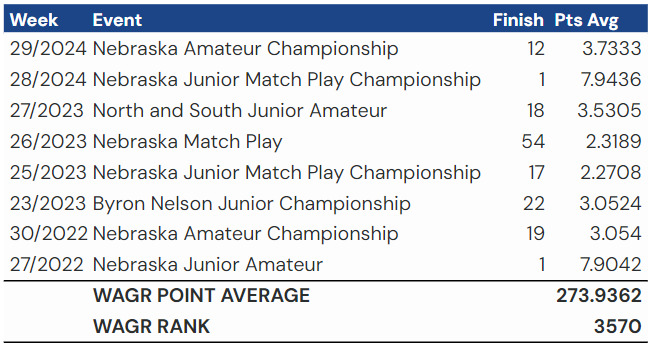
Related Content

Inspiring golfers to pursue this great game with drive and passion
Keywords
Related Posts
First of all, congratulations to Trevor Gutschewski for winning the 2024 U.S. Junior Amateur at Oakland Hills. Trevor survived a 23-hole opening match, took out the medalist in the second round and topped one of the best juniors in the world in the finals with an impressive -4 performance over 33 holes on "the Monster".
The USGA does a great job running the event and bringing the backstories to life via the telecast and through social media. You are likely aware that five U.S. Junior Team members made it to match play, including finalist Tyler Watts. Or that Trevor's dad Scott is on the PGA Tour.
There was one USGA tweet on Friday that caught my eye. It highlighted Trevor's relatively low WAGR ranking:

This couldn't possiby be correct, could it? I am familiar with Trevor and his game enough to know that this ranking seemed criminally low. Going into the U.S. Junior, he was ranked 76th overall on Junior Golf Scoreboard. I knew he was in the final pairing at this summer's Junior Byron Nelson. So I took a look at his WAGR profile page and saw these tournament results:

My gut reaction was that golfers in this range of WAGR typically have fewer than the minimum eight counting events. Therefore, their WAGR rank is suppressed until it's "fully baked" with eight or more events. At first glance, this helped explain Trevor's low rank. His divisor is 5.6603, so effectively his performances are being reduced by 30% because of the minimum. But that explanation hardly seemed rational given that Trevor first became a ranked player in the summer of 2022.
That's when it jumped out at me... where was his T3 performance at the 2024 Junior Byron Nelson? Somehow, the R&A and USGA missed this high finish. What looked like a clerical error would've cost him nearly 1800 spots on WAGR if you simply added the 5.415 points he would've received for the Junior Byron. Looking at Trevor's tournament history on Junior Golf Scoreboard, I realized that there wasn't just one omission. There were actually five tournaments dating from last August to this July that were missing from his WAGR profile, including a second place in the 2024 Nebraska Junior Amateur.
That's when I realized this was something more than just a clerical error. This was actually a known design feature of the WAGR system. Although the R&A receives full-field scores and finishes for every WAGR-eligible event, it chooses to only consider the ranking and performance of "ranked players." To become a ranked player, you have to score 6.5 points in a WAGR event. For junior events in the U.S., this is difficult to do. For most junior events, you have to win. Some higher-level AJGA events would give over 6.5 points for the second-place finisher. For the U.S. Junior, you'd have to advance to match play and win in the first round. Losing in the first round scored 5.68 points last year and thus wouldn't be enough for an unranked player to become ranked.
Becoming a ranked player is just half the battle. There is also a performance threshold for remaining a ranked player. From the WAGR FAQs: "How does a Ranked Player remain ranked? In order to remain a WAGR Ranked Player, a player must earn at least 4 ranking points in an event in the most recent 52-week period. If a player has been removed from the ranking, the player must once again take steps to become ranked before WAGR points can be earned again" (i.e. score 6.5 points in an event again).
It's this requirement that snagged Gutschewski. He only played in five WAGR events after first becoming a ranked player in July 2022. He failed to score four points in any of those events and was therefore dropped from WAGR after the North & South Junior in July 2023. He didn't become ranked again until he won the Nebraska Junior Match Play earlier this month. For WAGR purposes, it's as if Trevor never existed. His performance doesn't count towards his WAGR, and his existence in the field doesn't impact the WAGR power ranking of those tournaments (he's assigned the same replacement-level value as a player who has never been ranked).
It's worth noting that getting four points in a WAGR event in the U.S. is a tall task. There are only 63 American juniors who average more than four points per event. Four points is about equivalent to finishing 7th or 8th in a typical AJGA Open event. It's not altogether surprising to see a player go into a small slump and fall off of WAGR altogether. This is what happened to Trevor (Smith Summerlin and Jack Roberts are two other elite juniors who have met the same fate). Despite having a very strong spring with a few 5-6 point performances, none of those mattered when it came to his WAGR rank.
The other thing worth noting is that the four-point cut-off is completely arbitrary. One can't help but wonder what purpose it serves aside from saving the R&A some server space. One also can't help but wonder how things would be different if the cut-off didn't exist at all. Well, the second question is easy enough to answer. We can add Trevor's missing five events to his WAGR history and recalculate his point average. The table below shows he would be ranked 1627th instead of 3570th if all of his performances from the last two years were included. 1627th would rank him as the 54th-best junior golfer in the U.S., fairly consistent with his Junior Golf Scoreboard ranking.

They say winning cures everything, and perhaps that is somewhat true in Trevor's case. He's exempt into the next two U.S. Amateurs and next year's U.S. Open. Winning the US Junior will give Trevor 17+ points and boost his WAGR rank into the top 800. However, the discrepancy caused by the four point threshold still exists. If the five events were included, his WAGR rank would climb to around 300. That would make him the 5th highest ranked American junior on WAGR. And this impact is felt beyond just Gutschewski's WAGR ranking. The Power ranking of any tournament Trevor is in is adversely impacted. Based on our findings in Cracking the Power Formula, we know the difference in contribution between the 800th-ranked player and 300th-ranked player is approximately 12 (a big difference in junior tournaments!).
Perhaps Trevor's performance and this blog post can help shed a light on this odd policy decision and WAGR design feature developed by the R&A and co-signed by the USGA. Given WAGR's stated purpose is to "accurately rank players as they compete in competitions", the basic question to ask is whether a 3570 ranking that ignores most of this USGA Champion's recent performances is more accurate than a 1627 ranking that includes all of his performances over the last two years. Answering this question first can lead to bigger questions about the reasonableness and validity of other design choices made by the R&A in the generation of the World Amateur Golf Rankings.
Free E-mail Newsletter
Subscribe to the DRVN Golf Newsletter
DRVN Golf in your inbox, every month